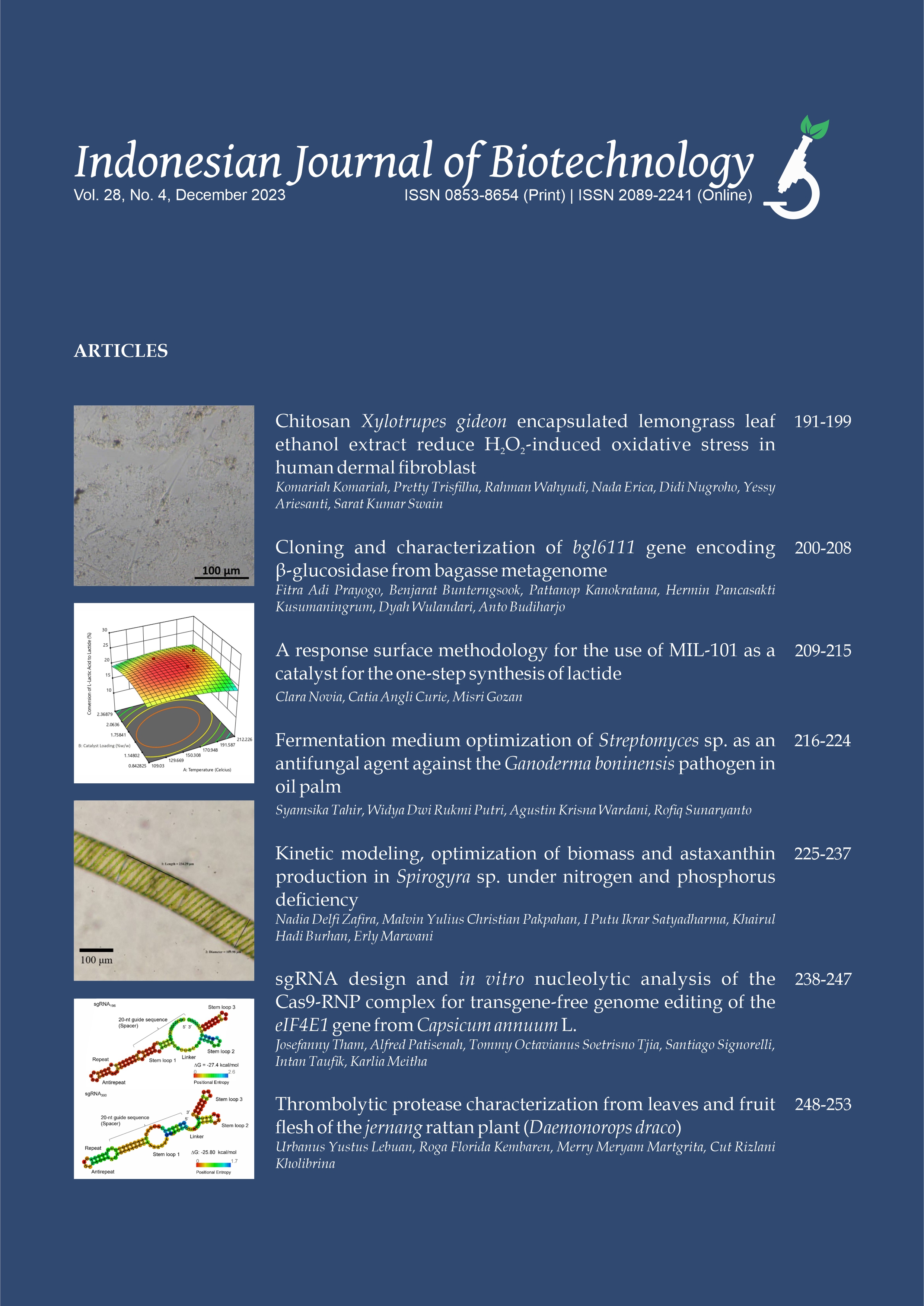Elimination of shallot bulb viruses through heat treatment
Margo Sulistio(1), Endang Sulistyaningsih(2), Siti Subandiyah(3*)
(1) Department of Biotechnology, Graduate School, Universitas Gadjah Mada, Yogyakarta, Indonesia
(2) Faculty of Agriculture, Universitas Gadjah Mada, Yogyakarta, Indonesia
(3) Faculty of Agriculture, Universitas Gadjah Mada, Yogyakarta, Indonesia Research Center for Biotechnology, Universitas Gadjah Mada, Yogyakarta, Indonesia
(*) Corresponding Author
Abstract
Keywords
Full Text:
PDFReferences
Almaarri, K., Massa, R., and Albiski, F. 2012. Evaluation of some therapies and meristem culture to eliminate Potato Y potyvirus from infected potato plants. Plant Biotechnology 29: 237–243.
Arisuryanti, T., Daryono, B. S., Hartono, S., dan A.A.G.R Swastika. 2008. Observasi dan identifkasi virus yang menginfeksi bawang merah di Jawa. Jurnal Perlindungan Tanaman Indonesia 14(2): 55-62.
Barg, E., Lesemann, D.E., Vetten, H.J., and Green, S.K. 1994. Identification, partial characterization and distribution of viruses infecting Allium crops in south and southeast Asia. Acta Horticultura 358:251-258.
Bhojwani, S.S. and Razdan, M.K. 1996. Plant Tissue Culture: Theory and Practice, Revised Edition. Nedherland: Elsevier.
Bos, L., Huttinga, H. and D.Z. Maat. 1978. Shallot latent virus, a new carlavirus. Neth. J. Plant Path. 84: 227-237.
Bos. 1983. Viruses and virus diseases of Allium species. Acta Hortic. 127: 11-29.
Budiarto K, Sulyo, Y., Rahardjo, I.B., and Pramanik, D. 2008. Pengaruh durasi pemanasan terhadap keberadaan Chrysanthemum virus-B pada tiga varietas krisan terinfeksi. J. Hort. 18(2):185-192.
Chen, J., Zheng, H. Y., Antoniw, J. F., Adams, M. J., Chen, J., and Lin, L. 2004. Detection and classifcation ofAllexiviruses from garlic in China. Arch. Virol. 149:435–445.
Converse, R.H. and Tanne, E. 1984. Heat therapy and stolon apex culture to eliminate Mild yellow-edge virus from Hood stawberry. Phytopathology 74: 1315-1316.
Dove, L.D. 1967. Ribonuclease activity of stressed tomato leaflets. Plant Physiol. 42: 1176-8.
Duriat, A.S. and Sukarna, E. 1990. Deteksi penyakit virus pada klon bawang merah. Bull. Penel. Hort. 8(1): 146-153.
Gambley, C.F., Thomas, J.E., Persley, D.M. and Hall, B.H. 2010. First report of Tomato torrado virus on tomato from Australia. Plant Disease 94(4): 486-486.
Gibbs, A., and MacKenzie, A. 1997. A primer pair for amplifying part of the genome of all Potyvirus by RT-PCR. Journal of Virological Methods 63(1-2): 9-16.
Goodman, R.N., Kiraly, Z., and Zaitlin, M. 1967. The Biochemistry and Physiology of Infectious Plant Disease. In Johnstone, G.R. and Wade, G.C. 1974. Therapy of Virusinfected Plants by Heat Treatment. Some Properties of Tomato aspermy virus and its Inactivation at 36°C. Aust. J. Bot. 2: 437-50.
Gunaeni, N., Wulandari, A.W., Duriat, A.S., dan Muharam, A. 2011. Insiden penyakit virus tular umbi pada tiga belas varietas bawang merah asal Jawa barat dan Jawa Tengah. J. Hort. 21(2):164-172.
Johnstone, G. R. and Wade, G. C. 1974. Some Properties of Tomato aspermy virus and its Inactivation at 36°C. Aust. J. Bot. 22: 437-450.
Kurniawan, A. dan Suastika, G. 2013. Deteksi dan Identifkasi Virus pada Umbi Bawang Merah. Jurnal Fitopatologi Indonesia 9(2): 47-52.
Langeveld, S.A., Dore, J.M, Memelink, J., Derks, A.F., van der Vlugt, C.L., Asjes, C.J., and Bol, J.F. 1991. Identifcation of Potyviruses using the polymerase chain reaction with degenerate primers. Journal of General Virology 72(7): 1531-1541.
Styer, D.J. and Chin, C.K. 1983. Meristem and Shoot tip culture for propagation, pathogen elimination and germplasm preservation. Hort. Rev. 5: 221-277.
Swari, F.S.P. 2016. Deteksi dan Identifikasi Virus-Virus yang Menginfeksi Bawang Merah di Kabupaten Bantul, Daerah Istimewa Yogyakarta. Tesis: Universitas Gadjah Mada.
Torres, A.C., Fajardo, T.V., Dusi, A.N., Resende, R.O., and Buso, J.A. 2000. Shoot tip culture and thermotherapy in recovering virus free plants of garlic. Hortic. Bras. 18(3): 192-195.
Van Dijk, P. 1993. Survey and characterization of Potyviruses and their strains of Allium spesies. Neth.J. Pl. Path. 99 (Suppl 2): 1-48.
Van Dijk, P. 1994. Virus disease of Allium species and prospect for their control. Acta Hortic. 358: 299- 306.
Voinnet, O. 2001. RNA silencing as a plant immune system against viruses. Trends in Genetics 17(8): 449-459.
Wulandari, A.W. 2016. Deteksi dan Eliminasi Virus pada Umbi Bawang Merah. Tesis: Institut Pertanian Bogor.
Article Metrics
Refbacks
- There are currently no refbacks.
Copyright (c) 2017 Indonesian Journal of Biotechnology

This work is licensed under a Creative Commons Attribution-ShareAlike 4.0 International License.









